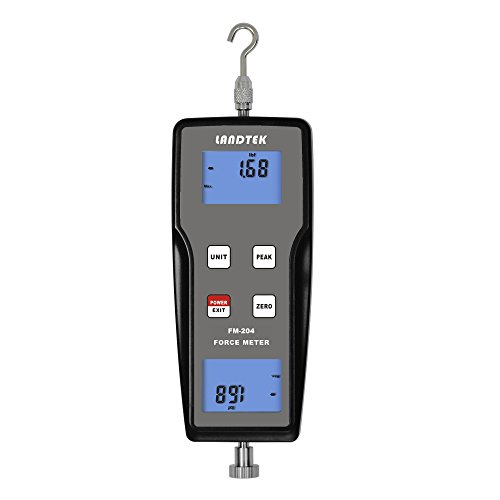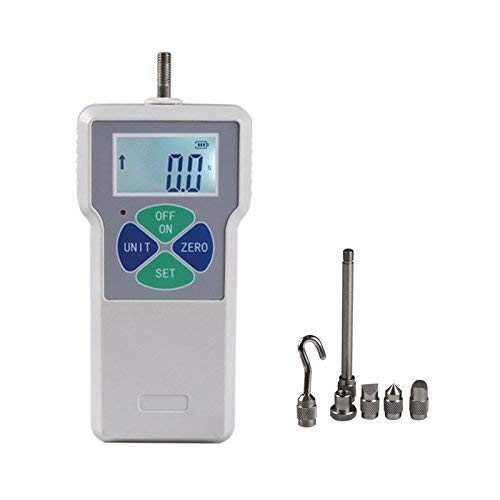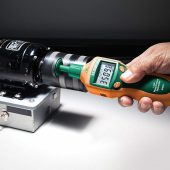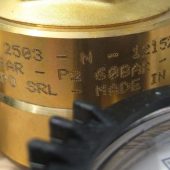A digital force gauge measures the amount of push or pull force. It’s also called a tension and compression force gauge or a push pull force gauge.
Digital force gauges are used in a wide range of industries and settings including manufacturing, research and development, quality assurance, standards testing and system maintenance.
Unlike traditional mechanical force gauges, digital force gauges are extremely accurate and much more versatile. They also offer the benefits of data storage and transfer.
These devices are typically small and easily portable. Readings are indicated on a small display screen with the option to switch between different units.
Uses And Benefits Of A Digital Force Gauge
One of the most common uses of a digital force gauge is in product testing.
Before they can release products, manufacturers need to be sure that they can withstand the rigours of frequent use and pass requisite safety and durability standards.
A digital force gauge can help determine what level of force it takes for the product to break or get loose.
A digital force gauge can also be used to check the ease of use of a product or part such as a car brake pedal or even a doorknob.
Organizations that maintain standards and provide certifications can also use a digital force gauge to check that products have achieved set standards.
Product testing using a digital force gauge is also common in the R&D phase of product development as well as quality assurance.
Outside product testing, digital force gauges are used in laboratories, system calibration, system maintenance and education.
As I mentioned, a digital force gauge has many advantages over a mechanical gauge.
Beyond the improved precision and versatility, the ability to save readings, recall them later and transfer them to a computer are major benefits. Though not all digital gauges offer these features.
Additionally, digital gauges are easier to integrate into a testing rig and some even accept input from external sensors.
- Read also: Best digital tachometers
What To Look For When Buying A Digital Force Gauge
The best digital force gauge depends on your work environment, what you are testing and the average amount of forces you expect to be testing.
For instance a gauge for testing light forces will be different in build quality and design from one that can test much larger forces.
Here’s what to look for when buying a digital force gauge.
1) Maximum load
This is the most important factor to consider when buying a digital force gauge. Manufacturers typically provide the maximum load in terms of Newtons (N) though it can also be shown in Kg and lbs.
Look for a gauge with a maximum load at least 20% more than the largest forces you’ll be measuring. This ensures you don’t get too close to or surpass the gauge’s maximum capacity, which could damage it or reduce its lifespan.
If you largest forces are 300N, look for a gauge with a maximum load of at least 360N.
Also check if there is a minimum load listed.
2) Accuracy and precision
To determine a gauge’s accuracy look for the precision or margin of error and resolution.
Precision is displayed as ± a certain percentage. A precision of ±0.5% is tight enough for most industries and applications.
Resolution refers to the gauge’s gradations or step size. This is sometimes listed as the load division value.
Most digital force gauges have a resolution of 0.1N or 0.01KG. The lower this number is, the more precise the gauge.
The level of precision you need depends on how sensitive your work is. If you have almost no margins of error – e.g. testing safety equipment – look for a gauge with lower step size. But 0.1N is precise enough for even the most accuracy-demanding applications.
3) Units
The main unit for force is Newton or N. But having extra units can be helpful in some situations.
Most gauges have at least three units: N, KG and LB. You can easily convert between them. Other gaiges may also display results in ounces and grams.
4) User-friendly display and interface
The gauge display should be easy to read in all light conditions. It should be backlit and the numbers large enough that you don’t have to squint to check the readings.
Also check that the control panel is easy to use with well-arranged and easily visible buttons.
5) Data storage and transfer
If you are working in an environment where you need to log readings and refer to them later, look for a digital force gauge with internal storage.
If you need to conduct further analysis on the data, look for one that allows easy transfer to a computer using a USB cable, SD card or some other means (wired or wireless).
Some gauges can be connected to a computer for constant data transfer. You can plot a graph as the gauge takes readings.
6) Working environment (temperature & humidity)
Because industrial working environments vary widely, it’s important to check that the gauge is safe for use in a particular environment.
Two important parameters to check are temperature and humidity. Most digital force gauges are designed to work properly in temperature range between 0 and 35ºC and relative humidity between 15 and 80%.
Using the gauge outside those parameters can affect precision.
7) Batteries
Finally, check where the gauge gets its power from. If you only use the gauge occasionally, AA batteries are good enough.
The batteries can last several hundred or thousand measurements.
If you are planning to use the force gauge a lot or continuously, a rechargeable battery is best.
The Reviews Of The Best Digital Force Gauges
1. Beslands SF-500 Digital Force Gauge
The Beslands SF-500 has a maximum load of 500N or 50KG (110LB). The minimum load it can display is 5N (0.51KG).
With a load division value of 0.1N, it is suitable for applications that demand high precision. The stated accuracy is ±0.5%.
Results are shown on a bright LCD screen which can display readings in N, KG or LB. There’s a unit button that allows you to quickly convert between units.
The SET button lets you record the peak reading and maintain it on the screen even after you’ve disconnected the gauge from the force. Press the ZERO button to start the next measurement.
The gauge runs off a 3.7V lithium battery that lasts up to 15 hours of continuous use. The battery recharges in 4-6 hours using the included charger.
The working temperature is 5-35℃ and the ideal relative humidity is 15-80%.
One feature that’s lacking is data storage and transfer. This gauge does not give you the option of storing readings or transferring them to a computer.
2. Extech 475040-SD Datalogging Digital Force Gauge
If you want a digital force gauge with data storage, I recommend the Extech 475040-SD. It stores up to 2 million readings on a removable SD card complete with date and time stamps.
The readings are stored in an excel format for easy transfer and analysis on a computer.
The gauge has a maximum load of 49N (5KG) with an accuracy of ±0.5%. It comes with four adapters for different applications. They include a hook for tension testing, a chisel, cone and flathead.
The display is large and bright. You can see the readings easily in any light.
Readings are displayed in four measurements: KG, LB, N and Ounces. The display also has a digital clock that you can adjust to your time zone.
Below the display is an easy to use control panel with buttons for setting to Zero, adjusting the sampling rate, setting peak hold and reversing display.
The reverse display button is handy when you need to use the gauge upside down. It ensures you can still read the measurements with ease.
Other features include auto power-off and low battery warning.
The gauge uses 6 AA batteries.
3. FM-204-100K Digital Force Gauge
This one is a good choice if you are looking for a high-capacity digital force gauge. It has a maximum load of 980N or 100KG (220LBs).
The resolution is 0.1N and the margin of error is ±0.5% ± 1.
The gauge features two displays so that you can read measurements no matter how the gauge is oriented. Both displays are backlit for easy visibility.
The 4-button control panel is located between the two displays. It has a button for changing measurement units (KG, LB and N), power, peak hold and zero.
The gauge has an operating temperature range between 0 and 40ºC and requires an environment with humidity less than 80%.
It runs off two AA batteries though there is the option of providing continuous power via a 6VDC supply. To save power, the turns off automatically after 10 minutes.
Accessories provided include a carrying case and 5 adapters. The adapters include a hook for tension, flat tip, cone tip and two V-shaped tips (wedge and groove).
Note that this gauge has no data storage nor does it have any kind of interface such as USB for real time data transfer.
4. L.HPT 10N/1kg Precision Digital Display Dynamometer
Generally, the lower the maximum load the more precise a force gauge is. The L.HPT digital force gauge with its 10N maximum load offers very high precision.
It’s ideal for sensitive applications where high accuracy is essential.
There are additional versions of this gauge with varying maximum loads. There’s one with a 0.2Kg max if you need even more precision and 50KG (500N) model if you often deal with large forces.
The threaded push-pull rod can be attached to different kinds of clamps, rods and hooks depending on your testing environment.
The screen displays units in three different units: N, KG and LB. You can change the unit using the UNIT button below the screen.
There’s also a button for Peak Hold and Zero.
The gauge comes with a 3.7V lithium battery that lasts about 15 hours of continuous use.
5. NK-50 50N Dial Mechanical Push Pull Gauge
If you prefer getting a mechanical force gauge, the NK-50 is a good and affordable choice. It’s a simple handheld gauge that can be used in a wide range of environments.
Obviously, it doesn’t have a digital display screen like the other gauges. Instead, it uses a more traditional analogue dial with a 0.25N gradation.
The maximum load is 50N (5KG) and the minimum load is 5N (0.5KG).
The dial has both a Newton and Kilogramme scale. It displays readings in the two unit simultaneously so you don’t need to switch between them.
Even though it is a mechanical gauge, it has a peak hold feature similar to digital gauges.
Just click on the knob and the scale will hold the needle at the highest reading. With the knob turned off, the needle moves continuously with changes in force.







